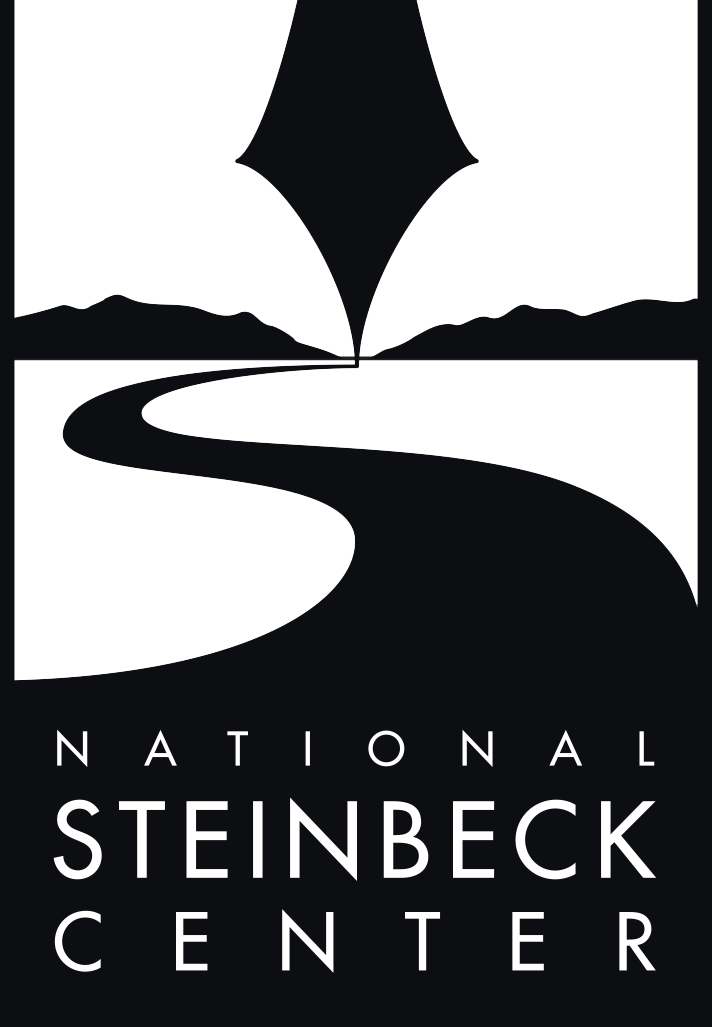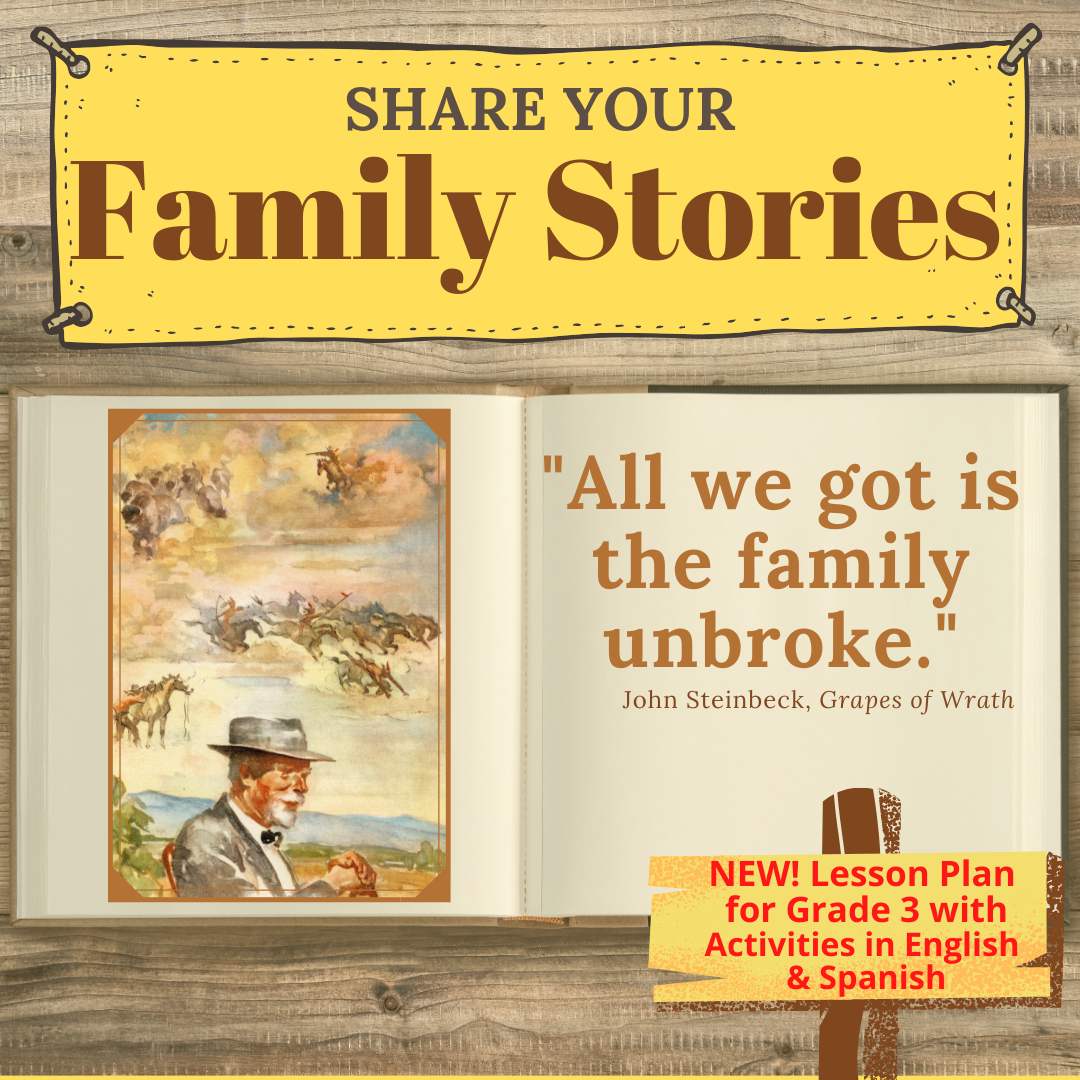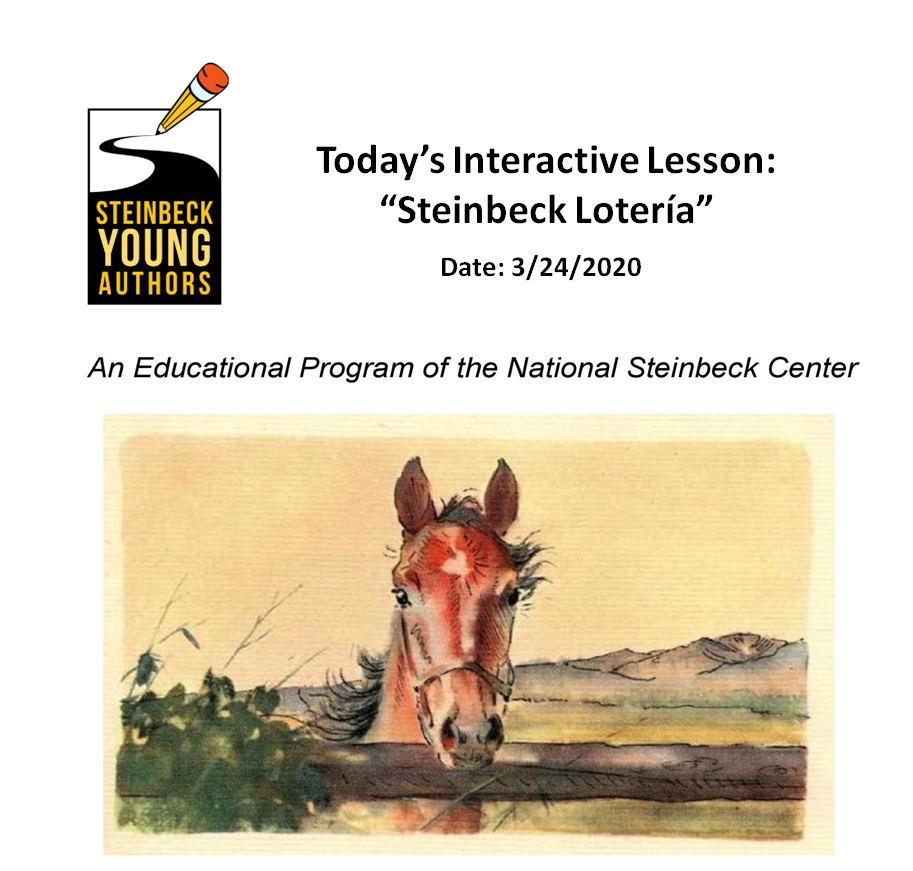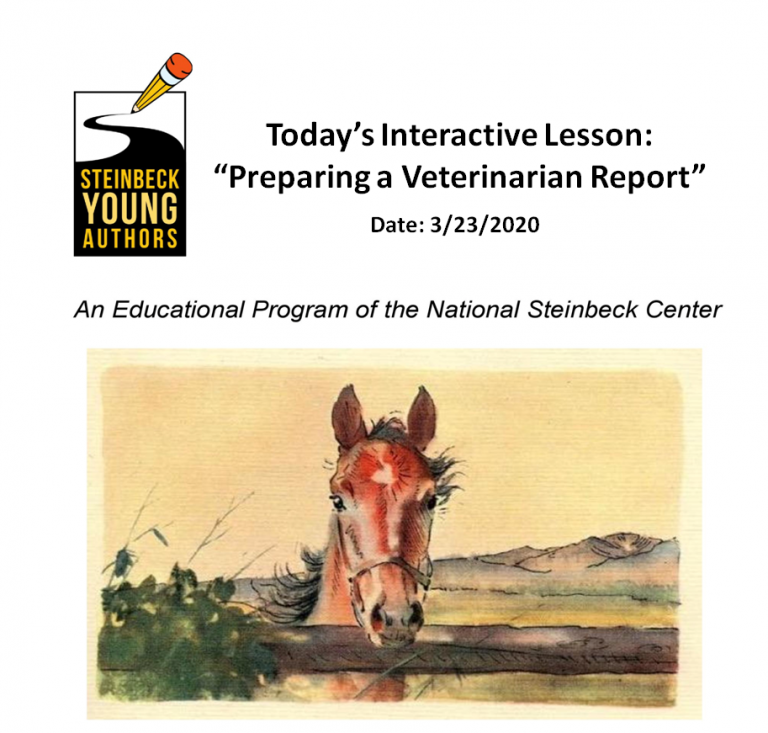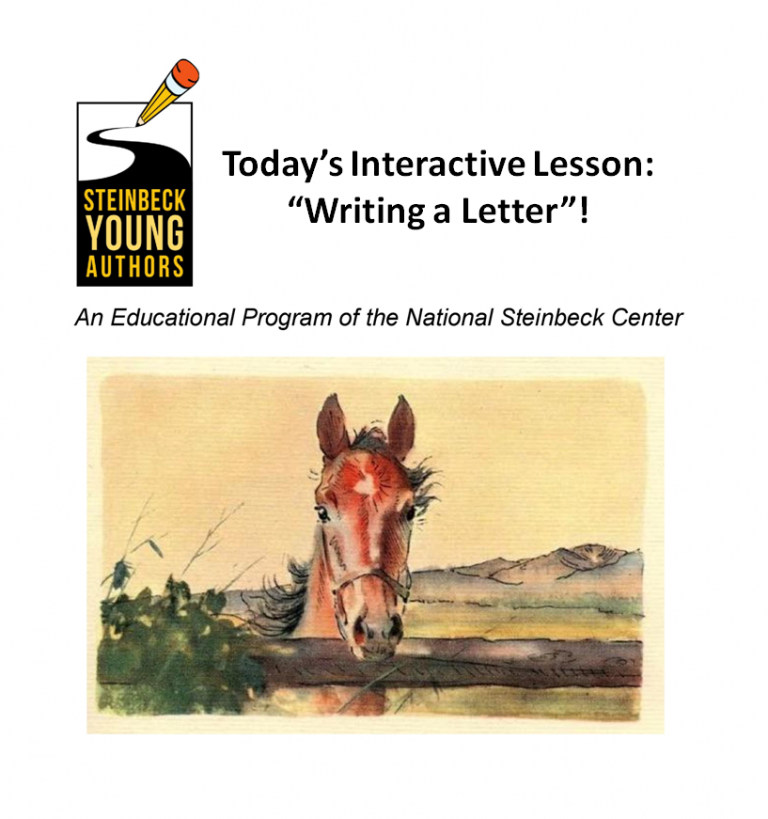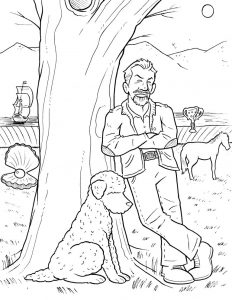Open Wednesday through Sunday 10am to 5pm
Learn
John Steinbeck Bio
Young Authors
Listening to America
Archives
Resources
Bibliography
Steinbeck Academic Conference
John Steinbeck Bio
John Steinbeck Bio
John Steinbeck was born in Salinas in 1902 to a middle-class family living a few blocks from Salinas’ bustling Main Street. His father, John Ernst Sr., worked as a manager in the local flour mill. Later, he owned a feed store and was later appointed Monterey County Treasurer. Steinbeck’s mother, born Olive Hamilton, was a former school teacher who enforced high academic standards for her children and encouraged a love of literature. John Steinbeck had three sisters: two older sisters Esther and Beth, and a younger sister Mary, whom Steinbeck was close to throughout their childhood together.
Schooling for Steinbeck showed an early love of storytelling and writing. In high school, a favorite teacher of Steinbeck, read his stories aloud to the class as positive examples, both embarrassing him due to his shyness and encouraging him to continue. He carried this love of writing to college, attending Stanford University’s growing selection of creative writing and English courses. However, the details of taking a full roster of requirements for graduation did not appeal to Steinbeck, so he left the University in 1925 without a degree, having taken the courses that interested him over six years.
Steinbeck’s early work and writing as an independent adult were varied and difficult. He worked at odd jobs, including construction work, journalism, as a winter caretaker for a Tahoe estate, and finally in a Tahoe fish hatchery. Throughout this assortment of jobs, Steinbeck tried to write in his free time. The job as a winter caretaker for a Tahoe vacation estate afforded him the most time to write; he finished his first novel-length manuscript, isolated in his cabin after long winters. This became The Cup of Gold (1929). While working at the hatchery the following summer, Steinbeck met Carol Henning, who would become his first wife. The couple married on January 14, 1930, in a courthouse ceremony.
Together, they lived as long as they could in Los Angeles until the money ran out, forcing them to move to the Steinbeck family vacation cottage in Pacific Grove. There, Carol worked a series of odd jobs herself, putting her skills as a secretary to good use, while Steinbeck wrote as much as he could. During this early period of his writing career, Steinbeck wrote The Pastures of Heaven, stories that became part of The Red Pony, The Long Valley, and To a God Unknown. However, his first commercial success came with the publication of Tortilla Flat. This was Steinbeck’s first book published with his new publisher and editor, Pascal Covici. He would remain Steinbeck’s friend and editor until his death in 1964.
After this turning point in Steinbeck’s career, he started work on some of the best-known pieces, including In Dubious Battle, Of Mice and Men, and the crowning achievement, The Grapes of Wrath. At its publication in 1939, The Grapes of Wrath was a controversial book. Steinbeck felt that it plagued the rest of his career: everyone from his literary agents to the reading public was waiting for another Grapes of Wrath. Unfortunately, after fame and fortune came to his life, Steinbeck’s marriage to Carol wavered and fell apart. They divorced in 1943, freeing Steinbeck to marry Gwyndolyn “Gwyn” Conger, whom he had met several years before.
With the dawning of the 1940’s, Steinbeck turned to the growing war effort, producing propaganda pieces supporting the American war effort. The Moon is Down rose to a level of prominence in Europe it never achieved in the United States. For occupied Europe, it became a well-loved work, passed clandestinely from reader to reader even when it could earn them a prison or death sentence. In 1943, Steinbeck experienced war for himself as a war correspondent, writing for the New York Herald Tribune and syndicated in every state except Oklahoma. Upon returning from the war, Steinbeck felt the need for something different. During the war, his injuries and experiences put him in a dark mood that lasted for many months afterward.
Finally moving out of his dark mood, Steinbeck wrote Cannery Row, a book that, in a 1953 essay, Steinbeck says that the soldiers asked for: something funny and not about the war, as they were sick of war. In this post-war period, Steinbeck also returned to pre-war material from his 1940 trip to Baja California, where he and Ed Ricketts went on a trip to collect marine specimens. The Pearl was the result of this tour of his recent past, a novella together with a film by Mexican director Emiliano Fernandez. He also wrote The Wayward Bus, which has its roots in Steinbeck’s time in Mexico.
However, two tragedies struck quickly in 1948: Ed Ricketts died from injuries sustained in a car accident with an oncoming train, and Gwyn asked for a divorce. Later that year, Steinbeck returned to the cottage in Pacific Grove, where he spent much of his time in the 1930s. The following year, he received a visit from actress Ann Southern, who brought along her friend, Elaine Scott. She would become Steinbeck’s third and last wife; the couple married less than a week after Elaine secured her divorce from actor Zachary Scott in December 1950. Then, in early 1951, Steinbeck turned to the “big novel” of his career, East of Eden, drawing on his own family history intertwined with the fictional Trask family. They play out a retelling of the Cain and Abel story. The novel took nearly a year to complete and was published in 1952.
Throughout the 1950s and 1960s, Steinbeck and Elaine traveled widely. Steinbeck finally achieved his goal of supporting their travels through journalism, written about the places they visited. The trip that stood out most for Steinbeck was a ten-month stay in Somerset, England, where Steinbeck worked on a modernized version of the King Arthur stories he loved from his childhood. It stood incomplete for the rest of Steinbeck’s life, though published posthumously in 1976. After months abroad for many years, Steinbeck turned back to his own country, writing about the United States in Travels With Charley and expressing his concern over moral decay in America in The Winter of our Discontent. Later, in America and Americans, Steinbeck returned to the issue of Americans, their culture, and what America was like in the mid-1960s. Although critical of excesses and moral laziness, Steinbeck was clearly sympathetic to Americans as a people and wrote about his belief in the potential Americans have for greatness.
In 1962, Steinbeck was awarded the Nobel Prize for Literature for his body of work. His is “realistic and imaginative writing, combining as it does sympathetic humor and social perception,” said Permanent Secretary of the Swedish Academy Anders Osterling in his presentation speech. In 1964, Steinbeck was awarded the Presidential Medal of Freedom by President Lyndon B. Johnson, with whom the writer was personally acquainted.
Steinbeck’s health continued to decline throughout the mid-sixties, and he eventually died at his home in New York City on December 20, 1968.
The National Steinbeck Center, a museum and cultural center in downtown Salinas, pays tribute to his life and lasting impact on American letters and American identity. The Steinbeck Museum explores his ecological vision, his commitment to social engagement, and his many stories about the working class—all of which ensure his work is deeply relevant today. Steinbeck’s books have been published in more than 45 languages, and he is, truly, a citizen of Salinas as well as a citizen of the world.
Young Authors
Steinbeck Young Authors Program
The Steinbeck Young Authors Program aspires to ignite the imagination of middle school students, specifically those in grades 6th to 8th. It seeks to lead them on an inspiring journey through the works of the legendary American author, John Steinbeck, while simultaneously encouraging the cultivation of their own unique narrative talents. Participating in this program offers a platform for students to not only express their artistic flair but also to deepen their appreciation for Steinbeck’s literary legacy.
Program Highlights:
Discovering John Steinbeck: Students will embark on a voyage into the world of John Steinbeck—his life, his creations, and the thematic tapestries he wove into his narratives.
Crafting Original Narratives: Encouraging young minds to channel their imaginative energies, the program invites students to craft their own original stories. This endeavor not only nurtures their writing acumen but also empowers them to articulate their distinctive voices.
Anthology Publication: The pinnacle of this journey is the anthology publication, which will feature submitted works by students. This honor is not merely a celebration of their creative endeavors, but an affirmation of their literary aptitude.
Steinbeck Center’s Day of Writing*: Two students, nominated by their teachers, will be granted the unique privilege of participating in the Steinbeck Center’s Writing Day here at the National John Steinbeck Center located in Salinas, CA. (Local Students Only*)
We firmly believe that the Steinbeck Young Authors Program will significantly enrich your student’s educational journey. By fostering a passion for literature, refining their writing skills, and nurturing their creative instincts, this initiative promises to be a transformative experience.
In order to facilitate seamless participation, we kindly request that you disseminate this information to your esteemed teaching colleagues. Linked at the bottom of this email, you will find a Google Form tailored for teachers who wish to partake in this year’s Steinbeck Young Authors program. The deadline for teachers to complete the form is set for Friday, September 29th, 2023. We kindly request that each teacher completes the form only once.
Following this, teachers can anticipate receiving their Google Drive links from education@steinbeck.org by no later than Friday, October 6th, 2023. Teachers can have their students start working on their writing as soon as teachers get their Google Drive resources. Student submissions are due by January 31st, 2024. We will be in contact about dates for the Day of Writing and the Steinbeck Young Authors Awards night as we approach the end of the semester.
If you are a School District, School or Teacher who would like to sign up for the 2025 program, please visit this Google Form.
Should any queries arise or further information be required, please do not hesitate to contact us at education@steinbeck.org.
Listening to America
Follow along with “Listening to America’s” Clay Jenkinson as he voyages in John Steinbeck’s footsteps and his “Travels with Charley” journey!
Stay up to date by visiting his website!

My Itinerary: Phase One: April 27-June 6, 2024
My plan is to drive about 250 miles per day. My intrepid scout Frank is getting me reservations in campgrounds. Months ago, I provided him with an elaborate set of criteria for choosing locations: county and state parks wherever possible and non-chain commercial campgrounds, unless KOA is the only option. I’ll spend at least one or two nights in Walmart parking lots. Connectivity matters! I’ll be posting photos and commentary virtually every day.
The plan looks like this. Get to the starting gate at Sag Harbor on Long Island: Bismarck to Fergus Falls, Minnesota; Fergus Falls to Mankato, Minn.; Mankato to Cedar Rapids, Iowa; Cedar Rapids to Ottawa, Illinois, home of my friend WGN Chicago radio talk show host John Williams, the brainiest of AM talk show hosts; Ottawa to Big Bone Lick, Kentucky, where Jefferson’s proteges Meriwether Lewis and William Clark dug up mastodon bones for the entry museum at Monticello; Big Bone Lick to Bethany, West Virginia, where I will interview the “bad boy of Steinbeck studies,” Bill Steigerwald, author of Dogging Steinbeck: Discovering America and Exposing the Truth about Travels with Charley; Bethany to Pennsylvania; Pennsylvania to Long Island, New York. I’ve studied his book carefully and printed out his blog prose from his 2010 50th anniversary retracing of Steinbeck’s 1960 journey. Steigerwald did important field research and concluded that:
A: Steinbeck embellished and even fictionalized some of Travels with Charley (TWC).
B: He actually stayed in his truck camper less often than he would have you believe.
C: His wife Elaine was with him for about 40% of the time, a fact he suppressed to keep up the appearance of a lonely journey through the heart of America.
D: He raced through long stretches of the journey to rendezvous with Elaine.
E: He didn’t always sleep where he said he did.
F: Although he said he had to travel incognito so that his fame would not distort the process, he used his celebrity when it was important.
I disagree with many of Steigerwald’s conclusions, and I think his mistook a work of travel literature by demanding punctilious and verifiable reportage. However, he has provided all future Steinbeck re-tracers with an excellent day-by-day guide to what Steinbeck saw and did.
The cad! Steigerwald wrote me an email saying that I could park in his driveway and if I needed a hot shower or a comfortable bed, I could be a guest in his house. I wasn’t born yesterday, Bill. I wrote back to say he was trying to lure me inside his house so that he could later denounce me for embellishing and fictionalizing my own journey! That, of course, was not his intention, but you cannot trust a muckraker on a journey like this.
When I finally reach Sag Harbor on the far end of Long Island around May 10, the actual Steinbeck journey begins.
In a nutshell: through New England to the top of Maine, which he insisted on touching so I will, too; then down through New Hampshire and Vermont to the Erie Canal, which I have always wanted to see; Niagara Falls; then along the underside of the Great Lakes to Chicago, where I will stay in the Ambassador East Hotel, where Steinbeck’s wife Elaine met him for a few days; then through Wisconsin and Minnesota (with stops at Sinclair Lewis’ Sauk Centre, and Frazee, where Steinbeck camped among a sea of turkey farms and Lake Itasca, the “true source” of America’s greatest river the Mississippi); and finally back to Bismarck.

Day 1
Sunday, April 28, 2024 — Well, I’m underway! After somehow managing to assemble a bike rack for my Listening to America Airstream (five hours, the worst instruction manual, bruised knuckles, and several bleeding injuries to my fingers), I locked the front door of my house. “Nothing to do now except go,” I said out loud. It was a chilly and still wintry morning in Bismarck, temperature 42, brisk wind, gray skies. I gassed up in the nearby village of Stirling, then drove nonstop to Fargo, North Dakota where I bought gas and a bag of pretzels. In mid-afternoon, I drove southeast to Fergus Falls, Minnesota, found the Swan Lake Resort, and checked in. The owners were at the lakeside putting docks into place for the summer. I could have stolen sundries, decals, patches, mugs, and t-shirts from the deserted office. Thoreau wrote, “I think we may safely trust a good deal more than we do.”
I chose Fergus Falls for my first stop because it was a moderate distance from Bismarck (262 miles) and because my maternal grandparents had a dairy farm here in the 1950s, ’60s, and ’70s. I don’t know what they would have thought of my career, but they would have been astonished that one can live a whole life without doing any real work. They worked hard every day of their lives; even on Sundays, the steers needed feeding, and the cows had to be milked, all 16 of them, with names like Petunia, Daisy, Whitey, Pal, and Blossom. They would have shaken their heads at the sight of a gleaming Airstream trailer. They seldom traveled far beyond Otter Tail County, Minnesota. They drove once to California, where they were fish out of water at Disneyland and on the LA freeways.
At the “Compass” site at Swan Lake Resort, once I got the rig hooked up to water and electricity, I began to unpack and find places in the cabinetry for clothes, electronic equipment, books (11), food, toiletries, notebooks, and other necessities. The camp hosts had invited me to supper (in the rural Midwest, dinner is served at mid-day), but I declined because I needed to get everything settled in the rig. But — in Steinbeck fashion — I invited them to stop by later. They did, about 8:45 p.m. They lit a fire in the firepit. They brought local beer and a half bottle of whiskey. They are young — in their later 30s. Anna had her 11-month-old baby swaddled in her arms. Tom served as drinkmaster. Anna brought a plate of outstanding carrot cake.
We talked for a couple of hours. About their decision to leave corporate America to buy a modest resort in a place where they had no kin. About the essential goodness of the people who come stay here. The resort doesn’t allow flags at the campsites, so they have no way to know people’s politics and generally avoid the topic. They wanted to know about my ambitious journey. I explained my quest. This led to a discussion of the State of the Nation as we approach America’s 250th birthday. They were thoughtful. Tom’s well-read and ready to talk.
Eventually, the fire subsided and we were all cold (except for the swaddled baby), so we called it a night. I tumbled into bed.
Day Two Begins
It’s a gray morning in northwestern Minnesota, but so far dry, 42 degrees, some wind in the still-bare trees. I’ll pack up soon and head to Mankato, 212 miles south. I want a full day here to finish unpacking and do some writing, but I’ve got to keep moving if I am going to get to the eastern tip of Long Island within 10 days.
Immediate conclusions:
1. Setting up camp only takes about 10 minutes — hose to the spigot, stout electrical cord into the gray metal box.
2. Nothing had tumbled around in the Airstream on a blustery day of driving with many road bumps and potholes. If you pack it right, there is no chaos upon arrival.
3. Driving a pickup-RV combination 60 feet long requires concentration (no texting!), and a few hundred miles will wear you out.
4. Given the spontaneous little party we scared up at my fire pit, and the quality of the conversation, I reckon that it’s going to be easy enough to Listen to America.
Archives
The Steinbeck Collection at the National Steinbeck Center started with a small donation of Steinbeck first-edition books in the 1960s. From humble origins and with the careful collecting and stewardship across decades by people dedicated to Steinbeck’s legacy, the Collection has grown to include approximately 40,000 items, ranging from manuscripts to newspaper clippings, and films to artwork.
The mission that drives the collection, preservation, and sharing of the items in the Steinbeck Collection is to document and share Steinbeck’s legacy. To that end, the collection includes items as varied as John Steinbeck’s life and experiences as a student, war correspondent, novelist, State Department emissary, and Nobel Laureate.
The highlights of the Collection are further described below. For more information about other parts of the Collection, such as foreign editions of Steinbeck’s works, critical analysis and review of Steinbeck’s life and writing, art, or film, please contact the Archivist at archives@steinbeck.org
Contact the Archivist
Please contact Guest Services for Archive Showings or Docent-led Tours at 831.775.4721
Resources
In an effort to support our amazing educators, we have officially launched the National Steinbeck Center’s Educational Resources web page, where you will find interactive lesson plans from our award-winning Red Pony curriculum, fun activities, interactive content and more that can be enjoyed from the comfort of your home.
The Time the Wolves Ate the Vice Principal
January 11, 2024
Interactive Activity 8 – Teaching The Pearl Curriculum Guide: Writing an I AM Poem
April 21, 2020
Poetry is a creative form of writing that allows people to express their feelings and ideas through the use of distinctive style and rhythm. Use the “I AM” model below to craft a poem from the point of view of a character from John Steinbeck’s novels or short stories. You can also choose to write one after a literary character that you read about recently. The poem should be no longer than one page. Study the poem on the second page to give you a better idea of how your poem can look like.
Let’s celebrate National Poetry Month together by show us your dramatic reading abilities and recording yourself (with your parent/guardian’s permission) reading it out loud portraying the character you chose and hash tagging #SteinbeckFromHome for a chance to be featured in our social media accounts. Be creative and have fun!
Interactive Activity 7 – Share Your Family Stories
April 7, 2020
Did you know that John Steinbeck’s maternal grandfather, Samuel Hamilton, was from Ireland and was one of the pioneer settlers of the town of Salinas during the 1850s? Steinbeck’s family history can be traced all the way back to his European roots. While we are all spending more quality time with our families at home, why not dive into your families’ histories and discover new tales about your past and ancestors.
Straight from our National Steinbeck Center Vault we are sharing a set of bilingual activities from our “A Century Ago in Steinbeck Country” Curriculum for Grade 3 that will provide students with a model for asking the right questions to dig deeper into their family history and find some true gems. Download the “Family Stories Lesson Plan for Grade 3” activities from the link above or click here!
Interactive Activity 6 – Steinbeck Scavenger Hunt
March 31, 2020
Today we invite you to take your Steinbeck knowledge and powers of deduction by participating in our virtual scavenger hunt! Download the clues from the link above (or click here) and use our virtual museum tour by visiting here (or here: www.steinbeck.org/visit/virtual-tour) to find the answers to the questions.
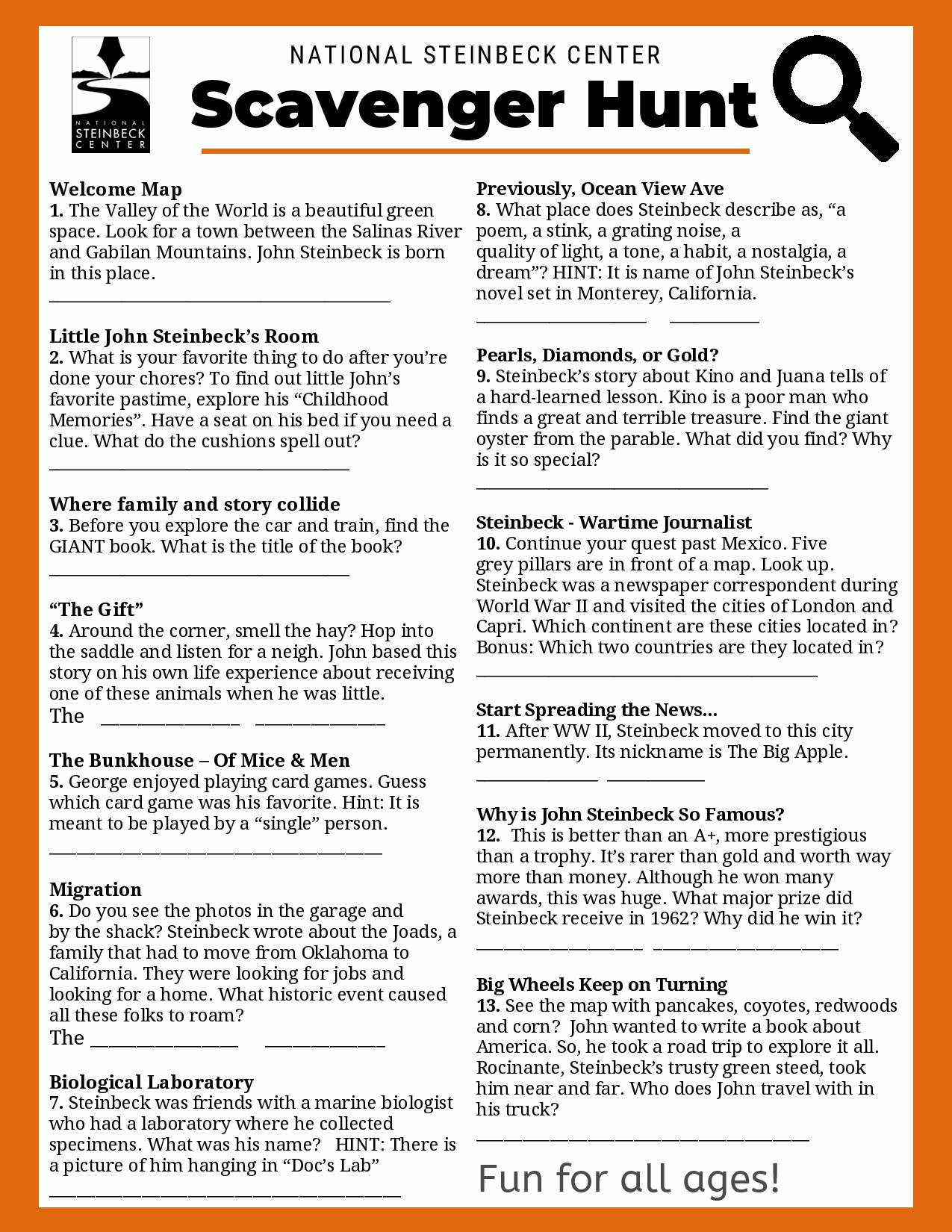
Record the time that it takes you to complete it and share it on our social media: www.facebook.com/nationalsteinbeckcenter!
Interactive Activity 5 – Interactive Activity 5 – Steinbeck Crossword Puzzle
March 29, 2020
Interactive Activity 4 – “Steinbeck Lotería / Mexican Bingo” Lesson Plan
March 24, 2020
Today we’re going to have a fun bilingual activity with “Steinbeck Lotería / Mexican Bingo”!
All the materials you will need to play this game are available on the download link above, including instructions and “Lotería” game cards. If you have any questions or if you’d like to suggest more interactive lesson plans, please send us an email to: SYA@steinbeck.org.
We also invite you to take a video or photo of your favorite board games and tag us @steinbeckcenter on your posts and we will share our favorites on our Instagram stories.
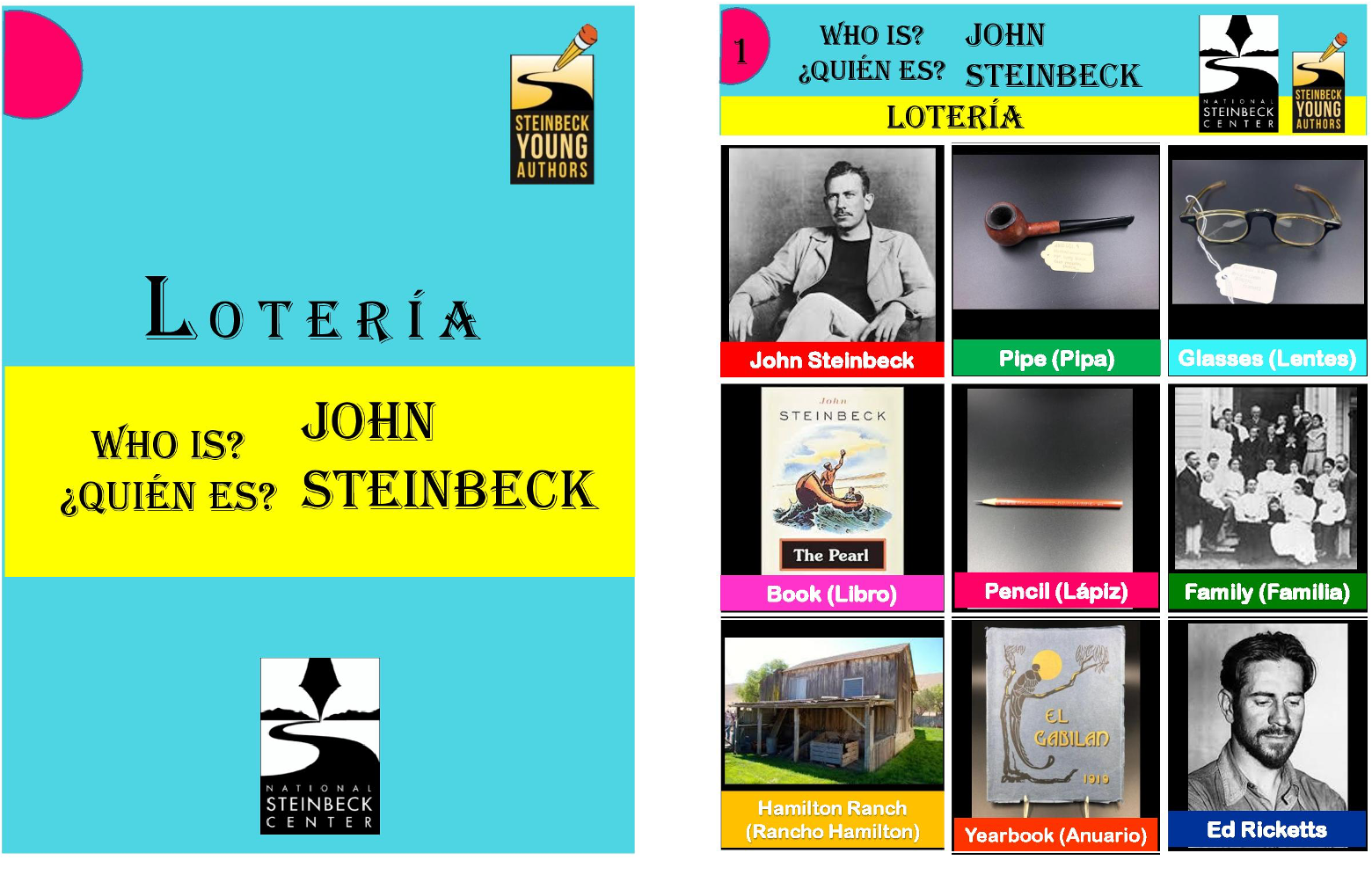
Interactive Activity 3 – “Preparing a Veterinarian Report” Lesson Plan
March 23, 2020
Today we’ll discover what it’s like to be a vet and learn about the fascinating world of horses! Tag us on social media with the hashtag #SteinbeckCenter with your favorite animal friend for a chance to be featured in our stories!
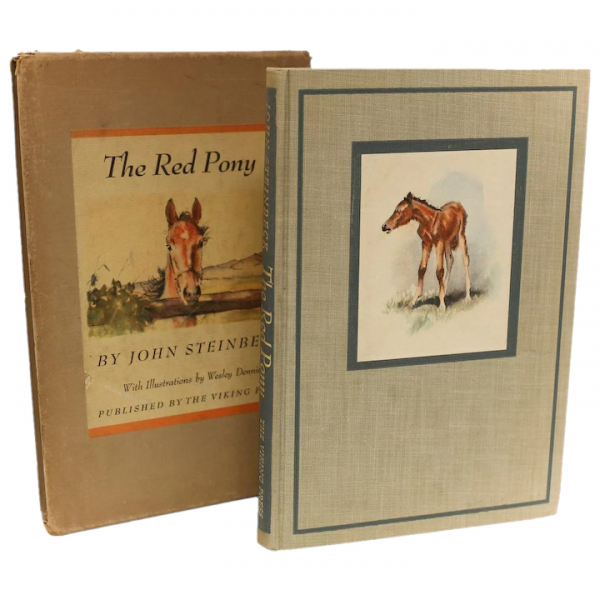
“No matter how good a man is, there’s always some horse can pitch him.”
-John Steinbeck, The Red Pony
Interactive Activity 2 – “Writing a Letter” Lesson Plan
March 20, 2020
Nowadays, writing letters can be a fun and quarantine-compliant way to show solidarity with one another. Learn to write a compelling letter to your favorite recipient by downloading our Red Pony curriculum “Writing a Letter” lesson plan from our Educational Resources web page.
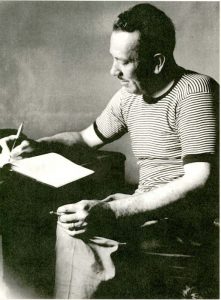
During John Steinbeck’s lifetime, letter writing was one of the most popular forms of communication.
Interactive Activity 1 – Steinbeck Coloring Sheets
March 19, 2020
Bibliography
Newsletter Archives
Summer 2023

Spring 2023

Early Spring 2023

Winter 2022

Fall 2022

Steinbeck Academic Conference

National Steinbeck Center’s next Academic Conference will be in 2024
For questions or more information, contact:
831.775-4721
or email
education@steinbeck.org
Join our email list and be the first to know about special events and more!
Visit Us
1 Main St, Salinas, CA 93901
831.775.4721
- Privacy Policy
- Terms of Use
Contact Us
National Steinbeck Center © 2021. All Rights Reserved.


